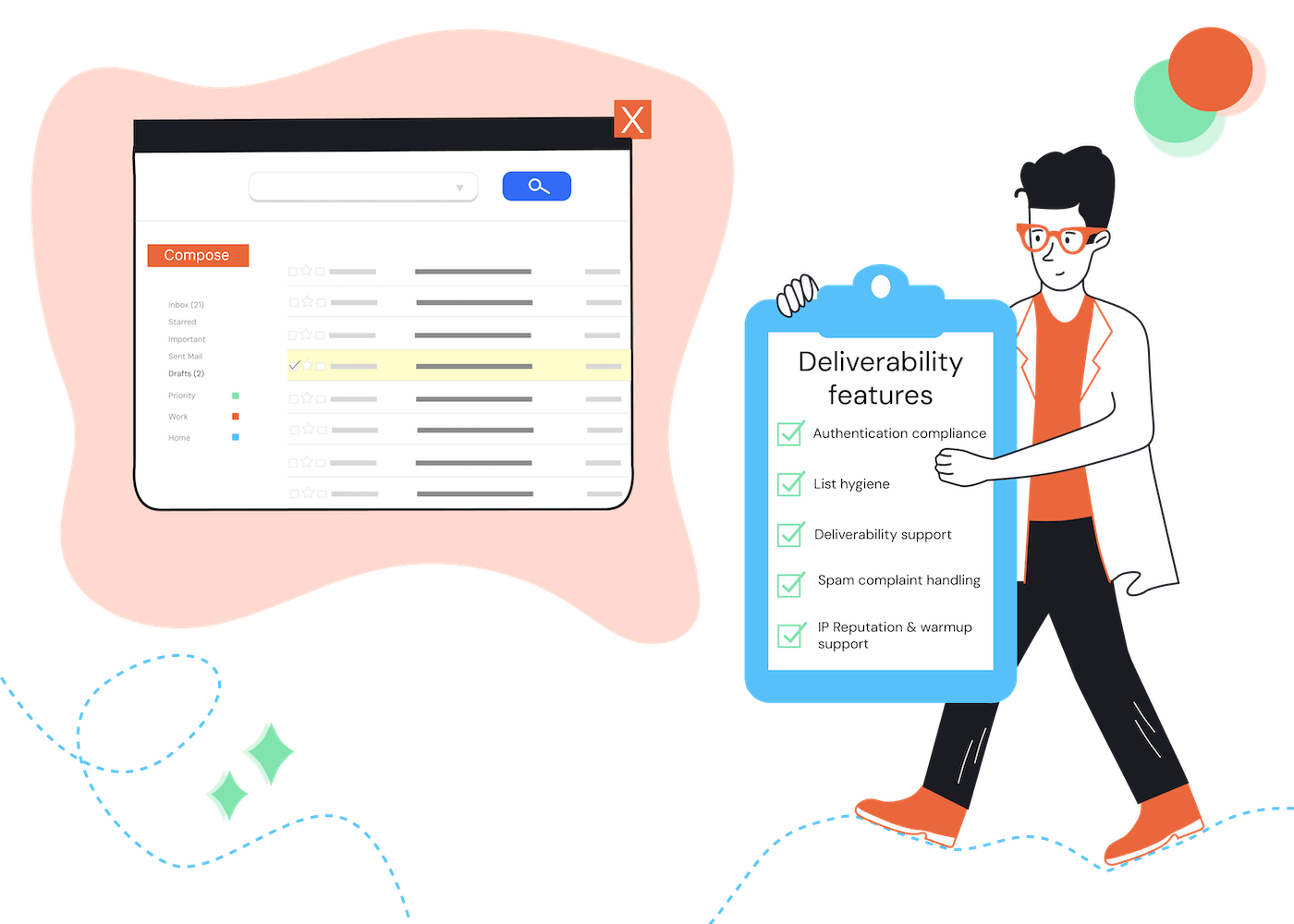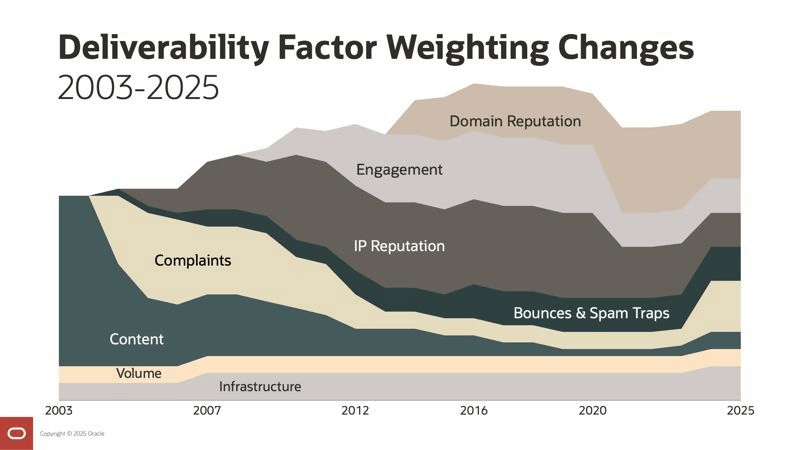For years, we published bi-annual deliverability test results, ranking our top email marketing providers on how well they landed in the inbox across popular email services like Gmail, Yahoo, and Outlook.
It seems that many of our readers found these rankings helpful, and over time, we received plenty of questions asking when the next results would be published. So I’m guessing, if you’ve landed here, you’ve probably noticed we haven’t updated those tests in quite a while…
In this article, we explain why we’ve moved away from publishing these results and why our new feature-based deliverability scoring provides a more reliable and actionable alternative for you and your team.
Why We Stopped Publishing Deliverability Tests
After running these tests for several years, we started to notice some limitations that made it harder to deliver results our readers could truly rely on.
While our original goal was to highlight clear winners based on inbox placement, over time, both readers (and deliverability experts) began raising valid concerns about the reliability of these rankings – and rightly so!
That’s why we decided to rethink our approach and focus instead on rating the actual deliverability features that help users improve their own results.
Here are the key reasons we chose to retire our bi-annual deliverability tests and switch up our methodology:
1. Seed List Testing Became Less Reliable
We previously used seed list testing services like GlockApps to measure inbox placement. These services send test emails to seedlist addresses across multiple providers to check where they land – Inbox, Spam, or Promotions.
Not only was it difficult to keep on top of the constant seedlist changes that Glock Apps presented us with, but we also discovered that these testing tools became increasingly inconsistent.
Test results often fluctuated depending on the seed list, test timing, and more… And we started to realise that the results didn’t always reflect real-world inbox performance for everyday senders.
2. Difficulties in Making Testing Conditions Fair
Some providers became very involved during the tests, and we suspected that they started optimizing their performance specifically for seed list addresses. This risked misleading results that didn’t reflect typical customer experiences.
Another challenge we ran into was that some email providers flagged our seed lists as “purchased” or “low-quality” contacts, violating their terms of service. Because seed lists are made up of hundreds of random, non-opted-in email addresses, uploading them often triggered account reviews and in some cases, even led to our accounts being flagged or temporarily suspended.
While our goal was legitimate testing, the nature of seed lists conflicted with many providers’ strict list policies. This made it nearly impossible to run consistent tests across all platforms without risking account restrictions or breaching their acceptable use policies.
3. Other Factors Became More Important in Influencing Deliverability
We have always acknowledged the fact that email deliverability is influenced by a variety of factors: your list, your content, your sender reputation, your sending practices, and more, not just the IP reputation of the email marketing platform itself.
Source: Daniel Deneweth on LinkedIn
Over time, we’ve seen that a platform’s IP reputation has become less of a determining factor in overall deliverability — especially after the “Yahoogle” changes in 2024. The infographic above also shows that spam complaints — and more importantly, domain reputation — have become significant factors since 2020.
That’s why narrowing our deliverability tests down to a single “winner” increasingly fails to reflect the complex challenges of reaching the inbox.
What We Do Instead: Feature-Based Email Deliverability Ratings
Rather than relying on unreliable seed list testing, we now evaluate our top email marketing platforms based on the deliverability features they offer, because these are the tools and the factors that help to improve their chances of landing in the inbox.
Here’s what we assess:
Authentication Compliance
- SPF, DKIM, and DMARC support: Does the platform help you properly authenticate your domain to protect your sender reputation?
- Authentication Wizard or Step-by-Step Guide: Is there an easy-to-follow setup process? The simpler this process is, the quicker users can get their authentication in place and ensure compliance.
Spam Complaint Handling
- Automatic bounce and complaint suppression: Does the platform automatically manage these to protect your reputation?
- Feedback Loop (FBL) data: Does it provide insights when recipients mark your email as spam?
Dedicated Deliverability Support
- Access to deliverability experts: Can you reach a dedicated deliverability team via chat, email, or calls?
- Deliverability dashboard: Do they provide a dashboard with insights into performance and inbox placement?
- Deliverability health score: Does it offer a score or health indicator to help you monitor your reputation?
List Hygiene
- List cleaning tools or integrations: Does the platform help you verify and clean your list to remove invalid or risky contacts?
- Strict policy on purchased lists: Do they prohibit using bought or rented lists?
IP Reputation & Warmup Support
- IP warmup guidance: Does it help you ramp up sending gradually to build a strong reputation?
We assign half-star scores for each of these features, resulting in a 5-star deliverability rating that helps you compare platforms based on what they provide to support your deliverability success.
So, without further delay, let’s dive into our latest feature-based email deliverability ratings. As we mentioned, we believe this new approach focuses on the practical tools and features providers offer to help you achieve better inbox placement. Let's take a look at how our top email marketing providers perform:
| Provider | Deliverability Features Star Rating | Comments |
|---|---|---|
| Klaviyo | 5.0 | Strong deliverability features including branded domain authentication, Deliverability Hub, expert team, and strict list hygiene. No limitations on deliverability features. |
| Omnisend | 4.5 | Excellent deliverability features, including full SPF, DKIM, and DMARC setup, in-app authentication wizard, dedicated deliverability support, and integrations with list-cleaning services. Lacks a deliverability score. |
| ActiveCampaign | 4.0 | Excellent authentication support with a wizard, bounce handling, responsive deliverability team. Recently introduced a paid 60-minute consultation service with in-house deliverability experts ($79) for tailored advice and setup guidance. Lacks a deliverability dashboard and health score. |
| Moosend | 4.0 | Full SPF alignment and DMARC guidance with hands-on support, list cleaning integrations, and IP warmup advice. No deliverability dashboard or deliverability score. |
| Kit | 4.0 | Supports proper email authentication with a setup wizard, consultation support, list cleaning on request; no dashboard or deliverability score. |
| MailerLite | 3.5 | Provides SPF and DKIM authentication with auto-setup, strict anti-purchased list policies, and external list-cleaning integrations. However, it currently doesn’t include DMARC guidance in its authentication setup, which can cause issues for some senders. No deliverability dashboard or deliverability score. |
| Brevo | 3.5 | Authentication support and automated setup wizard, basic deliverability dashboard, IP warmup, and support team. No built-in list cleaning or deliverability score, and lacks full SPF alignment. |
| GetResponse | 3.5 | Guided authentication plus list cleaning tools; offers solid deliverability support and IP guidance. No dedicated deliverability dashboard or health score, and does not enforce full authentication. |
| Beehiiv | 3.5 | Full authentication and setup wizard, IP warmup and deliverability support available, no list cleaning, deliverability score, or dedicated dashboard. |
| Mailchimp | 3 | Standard authentication and list policies with deliverability consultations; Does not have a dedicated dashboard, health score or list validation services, and finally, does not support full SPF alignment. |
Want to Improve Your Own Deliverability?
If you'd like to take control of your deliverability, download our Deliverability checklist:
- To set up SPF, DKIM, and DMARC correctly, you can book an authentication service with our founder, Robert.
- Follow our top topics on building and maintaining a healthy email list
- Avoiding spam triggers in your content
- Manage your sender reputation and engagement
Final Thoughts
While we no longer publish inbox placement rankings, we believe this feature-based evaluation offers a fairer, more actionable way to compare email service providers.
It highlights what really matters: the tools and support they give you to build your own strong deliverability practices.
Got questions about deliverability or choosing the right email provider? You can book a consultation call with Robert.
Otherwise, drop us a comment or get in touch. We’re always happy to help!
We keep our content up to date
10 Oct 2025 - Updated MailerLite's authentication information and added info about GetResponse deliverability consulting calls
Our Methodology
This article has been written and researched following our EmailTooltester methodology.
Our Methodology



